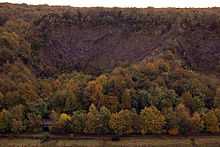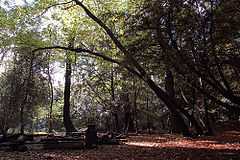Leigh Woods National Nature Reserve
| Leigh Woods | |
|---|---|
|
The woods in early autumn | |
| Type | open access woodland |
| Location | Bristol, England |
| Coordinates | N51:27 W2:38 |
| Area | 2 square kilometres (490 acres) |
| Operated by | National Trust, Forestry Commission |
| Status | Open all year |

Leigh Woods is a 2 square kilometre (490 acre) area of woodland on the south-west side of the Avon Gorge, opposite the English city of Bristol and north of the Ashton Court estate. It has been designated as a national nature reserve.[1] Small mountain biking circuits are present in the woods and the area is a popular walking area for Bristolians. Part of the woodland was donated to the National Trust in 1909 by George Alfred Wills,[2] to prevent development of the city beside the gorge. Areas not owned by the National Trust have since been taken over by the Forestry Commission.
To the south of the woods is an expensive suburb of Bristol also known as Leigh Woods. It is situated at the western end of the Clifton Suspension Bridge, which opened in 1864, making the development of Leigh Woods as an upmarket residential area practicable. Houses in varying styles were built from the mid-1860s until the First World War. Styles adopted included Italian, neo-Jacobean, Scottish baronial, Swiss chalet, domestic revival and arts and crafts.
At the western end of the bridge is Burwalls House, a Victorian mansion owned by the University of Bristol and currently used as a centre for continuing education. On a bluff overlooking the bridge is Alpenfels, a mock Swiss chalet constructed for the Wills tobacco family.
Topography
At the southern end of the wood is Nightingale Valley (one of several thus named in the area), a dry valley which is cut into the side of the gorge, and is on the Monarch's Way. It drops from nearly opposite the north gate of Ashton Court to the River Avon beside the western buttress of the suspension bridge. Stokeleigh Camp is a hill fort, thought to have been occupied from 3BC to 1AD and also in the Middle Ages,[3] which is on a promontory, bounding the north flank of the valley.
Proceeding north, down the Avon, there are a series of limestone and mineral quarries, now disused.
At the northern end of the woods is Paradise Bottom. This is part of the Leigh Court Estate and was part of the ground laid out by Humphrey Repton[4] for Philip John Miles. Some of the first plantings of the giant redwood and the Weymouth pine amongst other "exotics" imported to the UK were made here by Sir William Miles in the 1860s. In the late 19th and early 20th centuries this had an important celestine quarry and mineral line to a dock on the Avon; both are now derelict.[5] The area has of recent years been restored as an arboretum.
The Portishead Railway runs along the bottom of the woods. Between 1928 and 1932, the area had its own railway station, Nightingale Valley Halt.
Flora and fauna
Because of the rare flora and fauna the woods have been included in the Avon Gorge Site of Special Scientific Interest,[6] and has been designated as a national nature reserve.[7]
The south part of the woods is an area of former pasture woodland with old pollards, mainly oak and some small-leaved lime. To the north, the area comprises ancient woodland of old coppice with standards and contains a rich variety of trees. Rare trees include Bristol whitebeam (Sorbus bristoliensis) and wild service tree (Sorbus torminalis). On the steep grassy slopes above the River Avon, Bristol rockcress (Arabis scabra) which is unique to the Avon Gorge can be seen flowering in April; orchids and western spiked speedwell (Veronica spicata) are common in June and July.[2] In autumn the woodland hosts over 300 species of fungi.[8] Bilberry, a scarce plant in the Bristol area, is found in Leigh Woods, as is the parasitic plant yellow bird's-nest.[9] Lady orchid was discovered here in 1990, in Nightingale Valley; there is doubt as to whether this was a wild plant or an introduction.[10]
Birds which live in the woods include the raven (Corvus) and peregrine falcon (Falco peregrinus). Many butterflies and moths can be seen in summer including the white-letter hairstreak (Satyrium w-album).[2]
References
- ↑ "Leigh Woods NNR". Natural England. Retrieved 31 January 2010.
- ↑ 2.0 2.1 2.2 "Leigh Woods". National Trust. Retrieved 21 December 2013.
- ↑ "Avon Gorge". BBC Bristol. Retrieved 16 October 2007.
- ↑ "Walking in Leigh Woods". Avon Gorge and Downs Wildlife Project. Retrieved 2 February 2011.
- ↑ "Paradise Bottom". Industrial Railway Society Archive. Retrieved 16 October 2007.
- ↑ "Avon Gorge SSSI" (PDF). Natural England. Retrieved 7 January 2012.
- ↑ "Leigh Woods" (PDF). Avon Gorge and Downs Wildlife project. Retrieved 16 October 2007.
- ↑ "Leigh Woods NNR" (PDF). Natural England. Retrieved 7 January 2012.
- ↑ Myles (2000) page 108
- ↑ Myles (2000) page 251
Bibliography
- Myles, Sarah (2000) Flora of the Bristol Region ISBN 1-874357-18-8
External links
| Wikimedia Commons has media related to Leigh Woods National Nature Reserve. |
